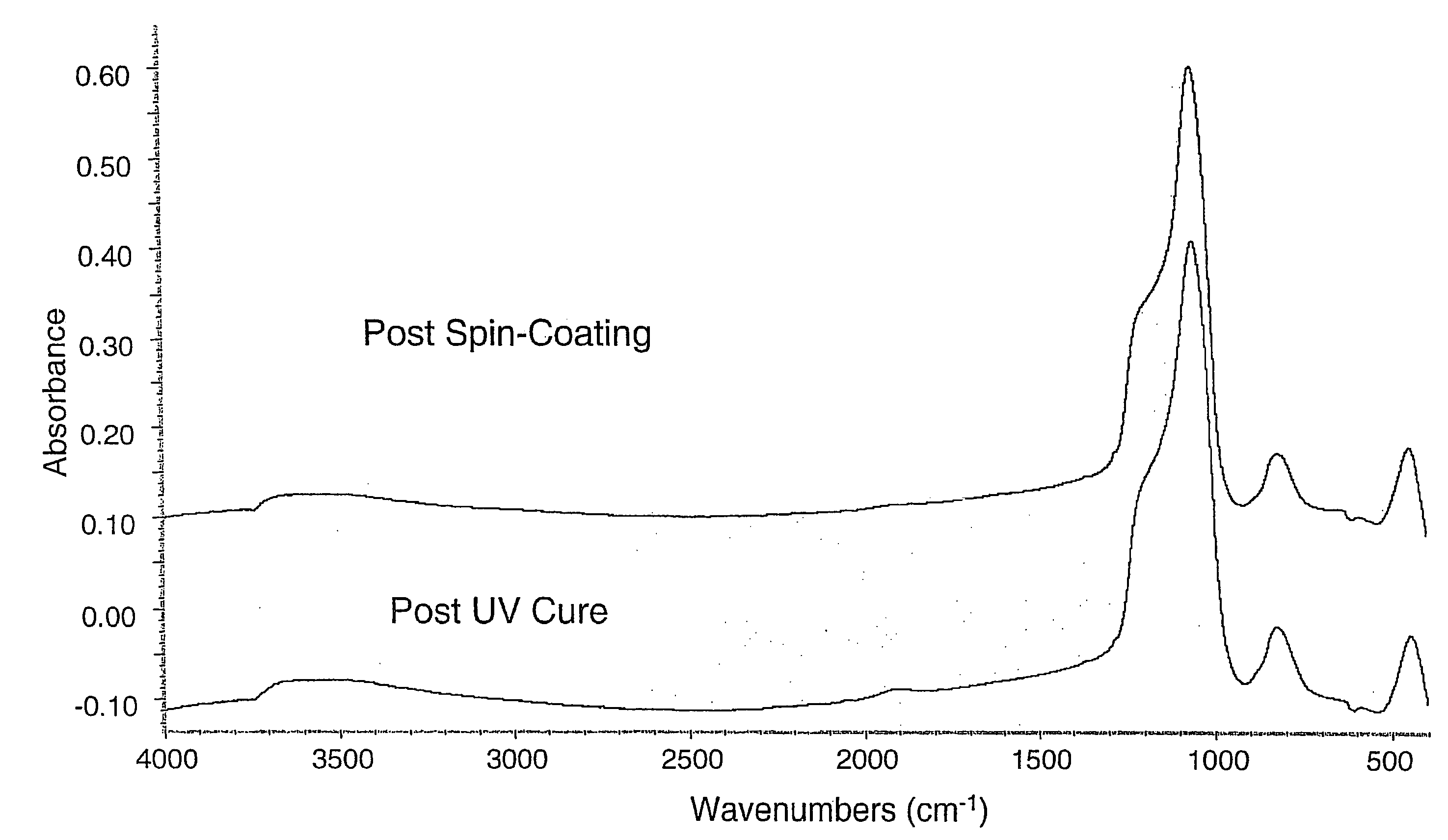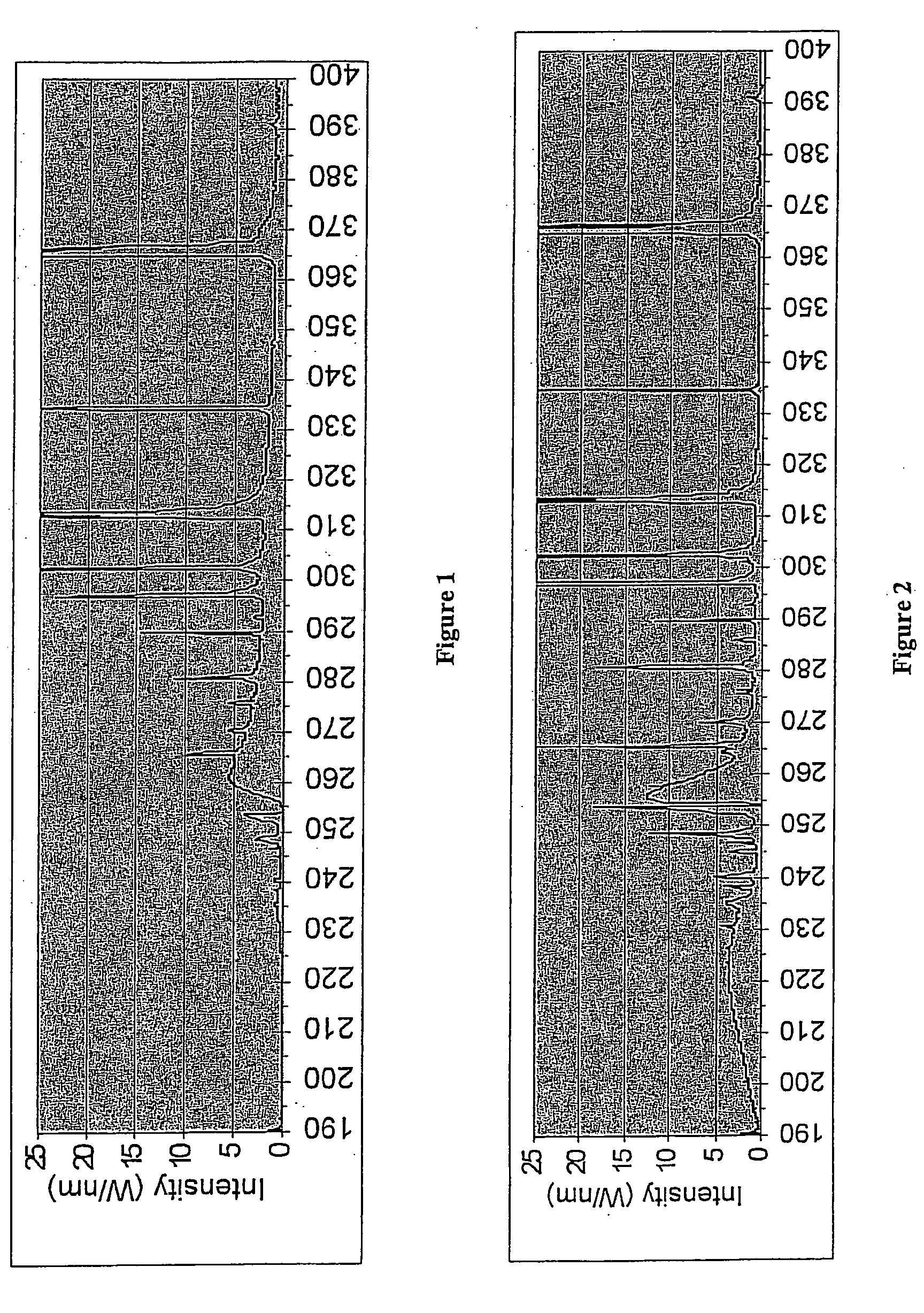Ultraviolet curing process for spin-on dielectric materials used in pre-metal and/or shallow trench isolation applications
a technology curing process, which is applied in the field of ultra-violet curing process of low-k dielectric film used in pre-metal and shallow trench isolation applications, can solve the problems of undetected exposure of the wafer to an elevated temperature for an extended period of time, and the temperature can exceed the allowable thermals budget of the manufacturer, so as to reduce the organic content of the dielectric material
- Summary
- Abstract
- Description
- Claims
- Application Information
AI Technical Summary
Benefits of technology
Problems solved by technology
Method used
Image
Examples
example 1
Wet Etch Resistance of Pre-Metal Dielectric Material
[0030] In this Example, a pre-metal dielectric material identified as Honeywell Electronic Material A (HEMA) and obtained from Honeywell Company was spin coated onto bare silicon wafers. The wafers were subjected to a conventional spin process recommended by the manufacturer. Each wafer was processed identically. The coated wafers were exposed to a UV cure process at 425° C. for a period of 5 minutes. The UV cure process employed various microwave electrodeless bulbs in a Rapid Cure Exposure tool commercially available from Axcelis Technologies, Incorporated. FTIR data as shown in FIG. 3 did not show any detectable absorbance changes in the low k dielectric material after the UV cure. The UV cured wafers were then exposed to a wet etching process that comprised immersing the wafers in a 40:1 and a 100:1 dilute hydrofluoric acid aqueous based solution for 2 minutes, 5 minutes, and 10 minutes. The above ratio represents the amount b...
example 2
Wet Etch Resistance of HEMA Based Spin-on Dielectric Material
[0032] In this example, the HEMA pre-metal spin-on dielectric material was spin coated onto blank wafers as in Example 1. In addition, a nanoglass spin on dielectric material available from the Honeywell Corporation under the identifier NGX was spin coated onto blank wafers. The wafers were exposed to UV radiation produced in the RapidCure tool utilizing a Type III electrodeless bulb at 425° C. for 10 minutes in an inert gas mixture. The thickness and the refractive index (RI) after the spin on dielectric was post baked and after the UV cure process were measured. Some of the wafers were further exposed to a furnace anneal process at 900° C. or 1000° C. for 1 hour. Percent shrinkage is calculated based on the thickness before and after UV cure process, and anneal, if applicable. In this Example, wafer set number 1 refers to the HEMA spin coated dielectric materials, and wafer set numbers 2 and 3 refer to the spin coated N...
example 3
[0035] In this Example, the dielectric constant and breakdown voltage was measured before and after the UV cure process as in Example 1. Spin low k dielectrics identified as HEMA (m1), (m2), and (m3) were coated using a conventional spin coat process as recommended by the manufacturer for the particular low k dielectric. The results are shown in Table 3 below.
TABLE 3HEMA (m1)HEMA (m2)HEMA (m3)PrePostPrePostPrePostUVUVUVUVUVUVCureCureCureCureCureCureDielectric7.846.916.276.197.66.7ConstantBreakdown0.581.881.992.041.242.27Voltage
[0036] In each instance, exposing the spin-on dielectric material to the UV cure process advantageously decreased the dielectric constant. Along with the decrease in dielectric constant a concomitant increase in breakdown voltage was observed.
PUM
 Login to View More
Login to View More Abstract
Description
Claims
Application Information
 Login to View More
Login to View More - R&D
- Intellectual Property
- Life Sciences
- Materials
- Tech Scout
- Unparalleled Data Quality
- Higher Quality Content
- 60% Fewer Hallucinations
Browse by: Latest US Patents, China's latest patents, Technical Efficacy Thesaurus, Application Domain, Technology Topic, Popular Technical Reports.
© 2025 PatSnap. All rights reserved.Legal|Privacy policy|Modern Slavery Act Transparency Statement|Sitemap|About US| Contact US: help@patsnap.com



